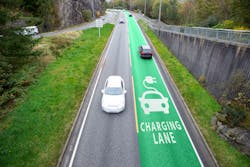Proactive Microgrids: Beyond just delivering power, integrating renewables, peak shaving, energy efficiency, resiliency, and cost savings
While the most talked about use cases for microgrids revolve around integrating renewables, peak shaving, grid supplementing, grid resiliency and smart controls, it is important to envision and unlock the potential of microgrids a little further.
When we combine artificial intelligence, data analytics and forecasting, cloud services and asset communication across various sections of an industrial activity beyond just power demand and supply, microgrids can play a vital role. For this, I suggest we think of microgrids in the spirit of manufacturing principles like lean manufacturing, just-in-time and agility.
Let’s take three such examples to illustrate what the microgrids of the future could look like:
Agile microgrids for smart on-road charging
With the growing adoption of on-road electric vehicles, it is becoming increasingly clear that the need for charging stations is paramount along road and route infrastructure. These charging stations could be microgrids that are set up as self-sufficient and independent power generation units. To maximize operating efficiently, optimize the life of the equipment and balance the OPEX costs of the charging station, advanced algorithms could be used to equip the charging station just enough to completely charge the vehicle(s) that are scheduled to stop by. For this, information from the vehicle such as trip information, battery health information and traffic information along the route will be communicated to a selected charging station and live coordinates will be transmitted. In addition to the vehicle information, weather data, generation asset health, lowest cost of electricity generation and greenhouse gas emissions will also be calculated, and electricity with the best possible combination will be produced. When the car pulls up to the station, the charging station will have sufficient energy to fulfill its needs. This will need closed loop communication between the vehicle(s) and the charging station.
Just-in-time microgrids for manufacturing
When thinking about a manufacturing setup, the most common use case for microgrids is peak shaving. As the site power demand increases over the base load, the microgrid assets kick in to provide additional power thereby reducing the peak power demand from the utility, which translates into significant cost savings. A proactive microgrid would be prepared for the energy demand by taking into account data and analytics from two sides – the plant side, or the energy required to perform operations based on planning, scheduling, machining, assembly, parts availability, supply chain, quality testing and processes -- and from the supply side of the power generation assets like monitoring of system health, weather conditions, price of electricity generated, etc. When these two data sets are meshed together, the microgrid knows exactly how much energy is needed over the very near future and will generate just enough to meet those demands. This will help improve the life span of the generation assets and eliminate the need to oversize the microgrid capacity.
Lean microgrids for aviation
With electrification of the aviation industry picking up speed, microgrids will play an important role for electric vertical take-off and landing (eVTOLs) and hydrogen-fueled engines. A sophisticated microgrid will mesh the air side and the land side power demand to provide optimal energy for the aircraft while also balancing the cost of generation and greenhouse gas emissions. From the air side, data regarding the health of the onboard battery, route planning, payload, turnaround route, weather conditions and ticketing data impacting in-flight power demand could be analyzed to provide the land side microgrid with the necessary information to calculate energy demand in real time. The land side microgrid can then take this data and measure it against the generation asset capabilities to be ready with the required amount of electricity or hydrogen (via electrolysis) to fuel up the aircraft when landed and ready for turnaround.
Challenges to be considered:
While none of these scenarios are too far from reality, there are some significant challenges that will have to be conquered as we work toward making such microgrids mainstream. As all these scenarios rely on the secure and accurate transmission of data, topics like data collection, storage and analysis, data privacy, data ownership, third-party data sharing, infrastructure (data centers) and communication gateways between these assets will have to be considered. Regulatory agencies and laws will also have a major say.
Arunachalam Lakshminarayanan is a senior engineer for Rolls-Royce Power Systems and a sustainable energy enthusiast.








